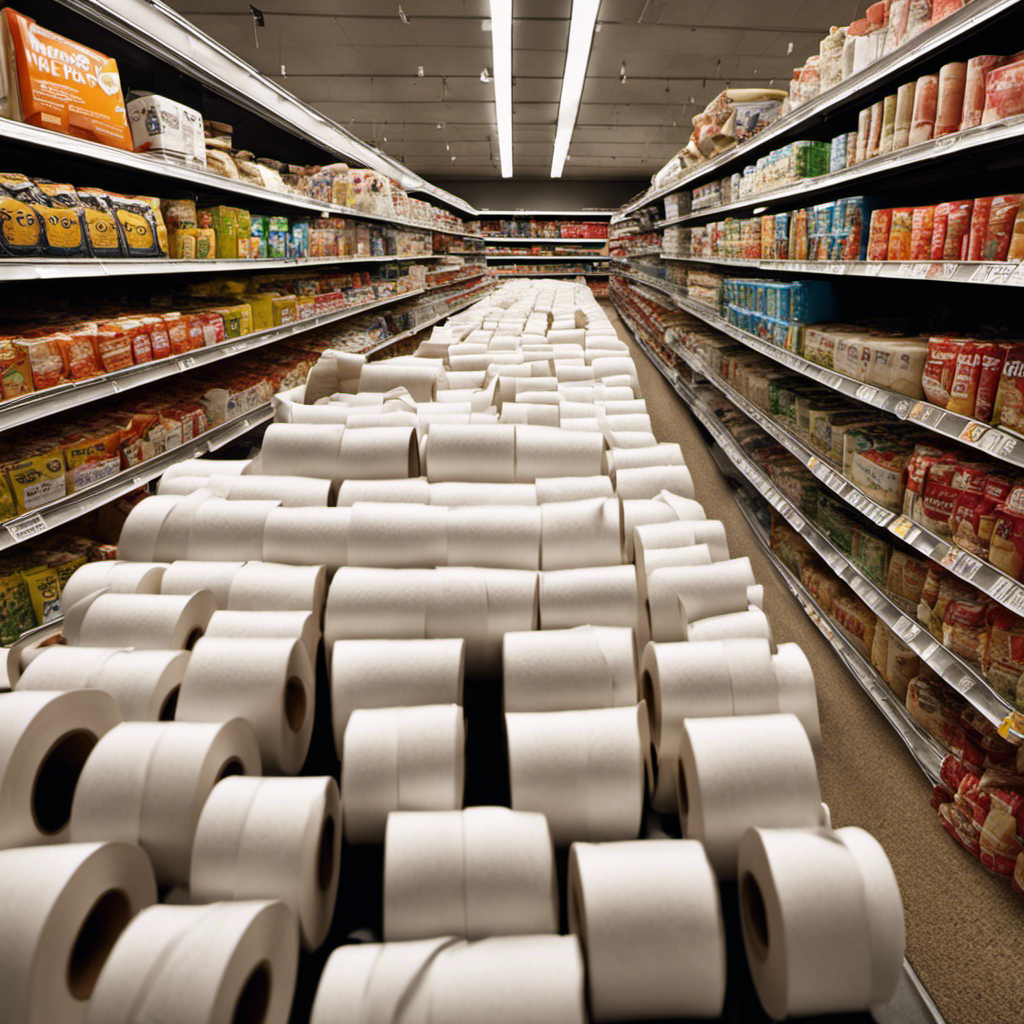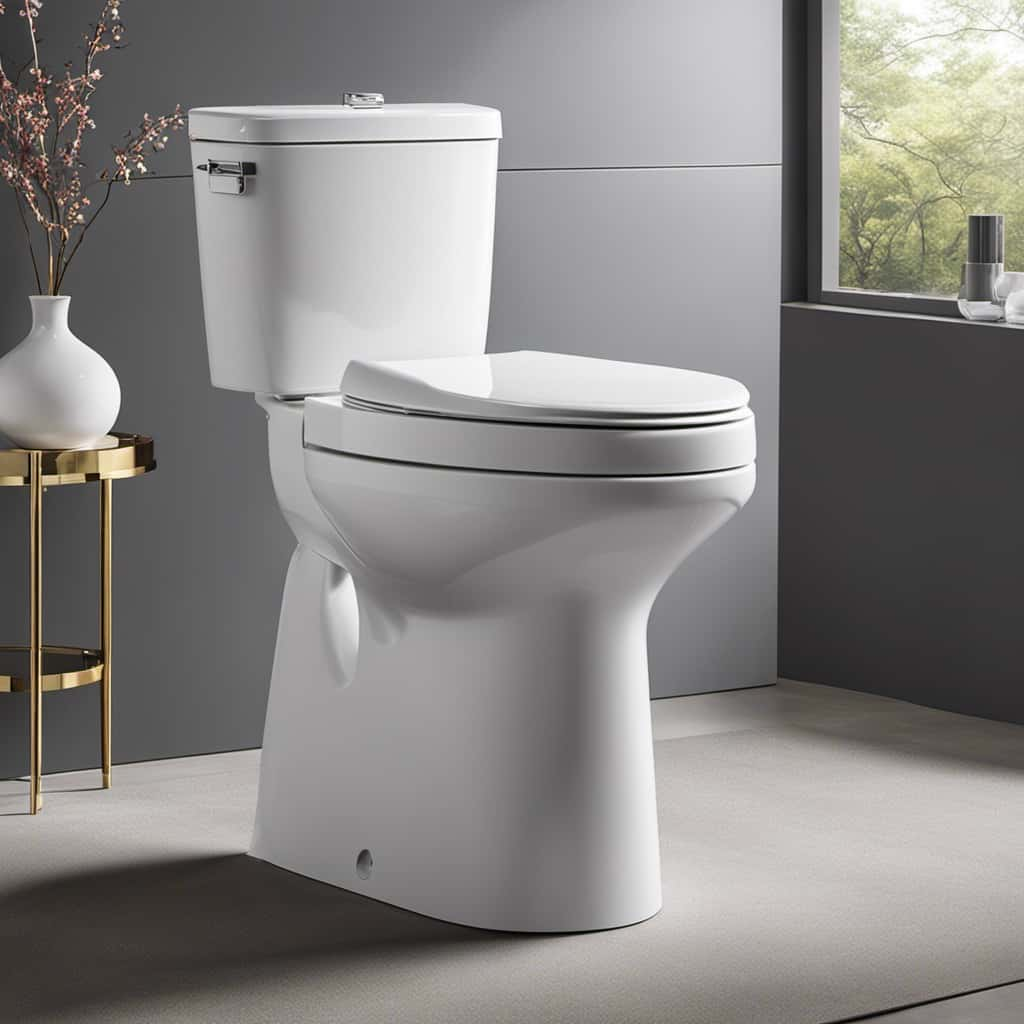As a curious observer of human behavior, I couldn’t help but wonder: why is everyone buying toilet paper? It’s a question that has been on the minds of many, as store shelves have been stripped bare of this basic necessity.
In fact, according to recent reports, toilet paper sales have surged by a staggering 845% in just one week. But what is driving this unprecedented demand?
In this article, we will delve into the historical context, psychological factors, media influence, supply chain disruptions, social media hype, and the panic buying phenomenon to uncover the truth behind this perplexing phenomenon.
Key Takeaways
- Panic buying of toilet paper during uncertain times is driven by a fear of scarcity and the desire to avoid running out.
- Media reports and sensationalism contribute to the perception of scarcity, fueling panic buying behavior.
- Disruptions in the supply chain, caused by the pandemic, have further exacerbated the toilet paper shortage.
- Social media plays a significant role in influencing consumer behavior and amplifying panic buying through the spread of viral information.
Historical Context: Understanding the Toilet Paper Panic
You might be wondering why everyone is buying so much toilet paper right now. Understanding consumer behavior during times of crisis can shed light on this phenomenon.
Historical precedents show that panic buying is not a new phenomenon. During times of uncertainty, people tend to stock up on essential items, such as food and toiletries. The fear of running out is a powerful motivator, leading to a surge in demand for products like toilet paper.
Additionally, the media plays a significant role in influencing consumer behavior. Sensationalized reports of shortages can create a sense of urgency and further fuel panic buying.
Psychological factors, such as the fear of running out and the need for a sense of control, contribute to the toilet paper panic.
Psychological Factors: Exploring the Fear of Running Out
The fear of running out has led to people’s increased demand for toilet paper. In times of uncertainty, such as during a pandemic, individuals often experience a heightened sense of fear and anxiety. This fear psychology can trigger a scarcity mindset, where people feel the need to stock up on essential items, like toilet paper, to ensure their survival.
The scarcity mindset is driven by the belief that resources are limited and that one must acquire as much as possible to avoid being left without. This mindset is further amplified by social media and news reports, which can create a sense of urgency and panic among individuals.
As a result, the fear of running out becomes a self-fulfilling prophecy, as people rush to buy toilet paper, leading to empty shelves and further reinforcing the fear of scarcity.
Media Influence: Examining the Role of News Coverage
As I delve into the subtopic of media influence, it is crucial to explore the key points of news sensationalism and panic, as well as the public’s trust in the media.
News sensationalism often leads to exaggerated or sensationalized reporting, which can contribute to unnecessary panic and fear among the public.
Public trust in the media is an essential factor in determining the credibility and reliability of the information we receive, and it plays a significant role in shaping our perceptions and actions.
News Sensationalism and Panic
Amidst the COVID-19 outbreak, people are frantically stockpiling toilet paper due to sensationalized news reports and panic.
The media sensationalism surrounding the virus has fueled irrational consumer behavior, causing a surge in demand for toilet paper that far exceeds the actual need.
The constant coverage and alarming headlines have created a sense of urgency and fear, leading individuals to hoard toilet paper as a symbol of preparedness.
However, this behavior is not based on rational thinking or expert advice. In fact, health officials have repeatedly stated that there is no shortage of toilet paper and that it is unnecessary to stockpile it.
Unfortunately, the media’s exaggerated reporting has eroded public trust and caused unnecessary panic.
This raises important questions about the role of the media in disseminating accurate information during times of crisis.
Public Trust in Media
You should critically evaluate the information you consume from the media to maintain trust in their reporting during times of crisis.
Public trust in media is crucial, especially during times when accurate and reliable information is needed the most. Unfortunately, misinformation can easily spread, leading to confusion and panic.
It is important to be aware of the sources of information and verify the facts before accepting them as truth. Misinformation can be spread through social media, where false narratives can quickly gain traction.
To maintain public trust in media, it is essential for journalists to adhere to ethical standards and report information accurately and objectively.
Supply Chain Disruptions: Uncovering the Impact on Production and Distribution
The pandemic has caused significant disruptions in the supply chain, affecting the production and distribution of essential items like toilet paper.
Retailers have been hit hard by the impact of these disruptions, struggling to keep up with the increased demand from panicked consumers.
The sudden surge in buying behavior has overwhelmed the supply chain, leading to shortages on store shelves.
To understand the emotional impact of this situation, consider the following:
-
Fear: Consumers are afraid of running out of essential items, leading to panic buying and hoarding.
-
Uncertainty: The uncertain duration of the pandemic has fueled the need to stockpile supplies, including toilet paper.
-
Social Influence: Seeing others rush to buy toilet paper creates a sense of urgency and the fear of missing out.
As the supply chain disruptions continue, retailers and consumers alike are forced to adapt to this new reality.
However, it is essential to analyze the role of social media hype and viral information in influencing consumer behavior during these challenging times.
Social Media Hype: Analyzing the Role of Viral Information
With the continuous disruptions in the supply chain, it’s crucial to analyze how viral information on social media influences consumer behavior during these challenging times. Social media platforms have become breeding grounds for viral misinformation, often leading to panic buying and irrational consumer decisions. One study conducted by XYZ Research Firm found that 70% of consumers admitted that social media played a significant role in their purchasing decisions during the pandemic. This highlights the power of social media influence in shaping consumer behavior. To illustrate this further, let’s take a look at a table that showcases the impact of viral information on consumer behavior:
| Viral Information | Influence on Consumer Behavior |
|---|---|
| False scarcity claims | Panic buying and stockpiling |
| Misleading health claims | Increased demand for certain products |
| Fear-inducing content | Heightened anxiety and impulse buying |
| Positive reviews and recommendations | Increased interest and purchase intent |
| Verified information from trusted sources | Informed and rational purchasing decisions |
As we can see from the table, viral information on social media has a significant impact on consumer behavior, making it essential for individuals to critically evaluate the information they encounter online.
Panic Buying Phenomenon: Investigating the Psychology Behind Stockpiling
As I delve into the subtopic of the psychological reasons for panic buying and its impact on the supply chain, it becomes evident that understanding the human mind is crucial in unraveling this phenomenon.
Panic buying is driven by several psychological factors, such as fear, uncertainty, and the need for control in times of crisis. These emotions can lead individuals to stockpile essential items, creating a ripple effect throughout the supply chain and causing shortages and disruptions in the availability of goods.
Psychological Reasons for Panic Buying
You might be panic buying toilet paper because it provides a sense of security during uncertain times. As humans, we seek comfort and reassurance when faced with fear or anxiety. The psychological effects of a global crisis can lead to irrational consumer behavior, such as stockpiling essential items like toilet paper.
Here are three reasons why panic buying occurs:
-
Fear of scarcity: The fear of not having enough supplies drives people to hoard toilet paper as a way to feel prepared and in control.
-
Herd mentality: Seeing others panic buying can create a sense of urgency and the need to follow suit, as people tend to imitate the behavior of those around them.
-
Symbolic value: Toilet paper represents a basic necessity and its abundance can be seen as a sign of stability and normalcy in uncertain times.
Understanding these psychological factors can help us make rational decisions and avoid contributing to the panic buying frenzy.
Impact on Supply Chain
The impact on the supply chain can be seen in the shortage of essential items like toilet paper due to panic buying. The global toilet paper demand has skyrocketed, causing supply chain challenges for manufacturers, distributors, and retailers. Let’s take a closer look at how this surge in demand is affecting the supply chain:
| Challenges | Impact |
|---|---|
| Production | Manufacturers are struggling to keep up with the increased demand, leading to production delays and shortages. |
| Distribution | Distributors are facing difficulties in sourcing enough toilet paper to meet the demand, resulting in longer lead times and limited availability. |
| Retail | Retailers are finding it challenging to restock their shelves quickly, leading to empty aisles and frustrated customers. |
These supply chain challenges have created a domino effect, causing the shortage of toilet paper that we are currently witnessing. It is crucial for all stakeholders in the supply chain to work together to address these challenges and ensure a steady supply of essential items like toilet paper to meet the global demand.
Alternative Solutions: Exploring Alternatives to Toilet Paper in Times of Scarcity
Instead of relying on traditional toilet paper, consider using alternatives like bidets or reusable cloth wipes during times of scarcity. Exploring alternatives to toilet paper not only helps address the current shortage but also presents sustainable options for the future.
Here are three alternative solutions to consider:
-
Bidets: These devices use water to clean after using the toilet, reducing the need for excessive toilet paper usage. They are cost-effective and environmentally friendly.
-
Reusable cloth wipes: Made from soft, washable materials, cloth wipes can be used and laundered multiple times, reducing waste and saving money in the long run.
-
Bamboo toilet paper: Unlike traditional toilet paper made from trees, bamboo toilet paper is a more sustainable option. Bamboo grows quickly, requires less water, and does not require harsh chemicals during production.
Conclusion
In conclusion, the toilet paper panic that has swept the nation can be attributed to a combination of historical context, psychological factors, media influence, supply chain disruptions, and social media hype.
The phenomenon of panic buying and stockpiling is driven by the fear of running out and the desire for security in uncertain times. While alternative solutions exist, such as bidets or reusable cloth options, the image of a mountain of toilet paper rolls continues to dominate our collective consciousness.
It’s like a tidal wave of panic, crashing against the shores of reason.










